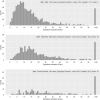Assessment of physiological signs associated with COVID-19 measured using wearable devices
- PMID: 33299095
- PMCID: PMC7705652
- DOI: 10.1038/s41746-020-00363-7
Assessment of physiological signs associated with COVID-19 measured using wearable devices
Abstract
Respiration rate, heart rate, and heart rate variability (HRV) are some health metrics that are easily measured by consumer devices, which can potentially provide early signs of illness. Furthermore, mobile applications that accompany wearable devices can be used to collect relevant self-reported symptoms and demographic data. This makes consumer devices a valuable tool in the fight against the COVID-19 pandemic. Data on 2745 subjects diagnosed with COVID-19 (active infection, PCR test) were collected from May 21 to September 11, 2020, consisting of PCR positive tests conducted between February 16 and September 9. Considering male (female) participants, 11.9% (11.2%) of the participants were asymptomatic, 48.3% (47.8%) recovered at home by themselves, 29.7% (33.7%) recovered at home with the help of someone else, 9.3% (6.6%) required hospitalization without ventilation, and 0.5% (0.4%) required ventilation. There were a total of 21 symptoms reported, and the prevalence of symptoms varies by sex. Fever was present in 59.4% of male subjects and in 52% of female subjects. Based on self-reported symptoms alone, we obtained an AUC of 0.82 ± 0.017 for the prediction of the need for hospitalization. Based on physiological signs, we obtained an AUC of 0.77 ± 0.018 for the prediction of illness on a specific day. Respiration rate and heart rate are typically elevated by illness, while HRV is decreased. Measuring these metrics, taken in conjunction with molecular-based diagnostics, may lead to better early detection and monitoring of COVID-19.
Conflict of interest statement
All authors are funded by Fitbit Inc. The authors have no non-financial competing interests.
Figures






Similar articles
-
COVID-19 surveillance based on consumer wearable devices.Digit Health. 2024 Apr 24;10:20552076241247374. doi: 10.1177/20552076241247374. eCollection 2024 Jan-Dec. Digit Health. 2024. PMID: 38665889 Free PMC article.
-
Safety and Efficacy of Imatinib for Hospitalized Adults with COVID-19: A structured summary of a study protocol for a randomised controlled trial.Trials. 2020 Oct 28;21(1):897. doi: 10.1186/s13063-020-04819-9. Trials. 2020. PMID: 33115543 Free PMC article.
-
Physiologic Response to the Pfizer-BioNTech COVID-19 Vaccine Measured Using Wearable Devices: Prospective Observational Study.JMIR Form Res. 2021 Aug 4;5(8):e28568. doi: 10.2196/28568. JMIR Form Res. 2021. PMID: 34236995 Free PMC article.
-
Detection and Monitoring of Viral Infections via Wearable Devices and Biometric Data.Annu Rev Biomed Eng. 2022 Jun 6;24:1-27. doi: 10.1146/annurev-bioeng-103020-040136. Epub 2021 Dec 21. Annu Rev Biomed Eng. 2022. PMID: 34932906 Free PMC article. Review.
-
Can Wearable Devices Accurately Measure Heart Rate Variability? A Systematic Review.Folia Med (Plovdiv). 2018 Mar 1;60(1):7-20. doi: 10.2478/folmed-2018-0012. Folia Med (Plovdiv). 2018. PMID: 29668452
Cited by
-
Sleep and COVID-19. A Case Report of a Mild COVID-19 Patient Monitored by Consumer-Targeted Sleep Wearables.Sensors (Basel). 2021 Nov 28;21(23):7944. doi: 10.3390/s21237944. Sensors (Basel). 2021. PMID: 34883947 Free PMC article.
-
Impact of COVID-19 on IoT Adoption in Healthcare, Smart Homes, Smart Buildings, Smart Cities, Transportation and Industrial IoT.Sensors (Basel). 2021 Jun 1;21(11):3838. doi: 10.3390/s21113838. Sensors (Basel). 2021. PMID: 34206120 Free PMC article. Review.
-
Measurement of respiratory rate using wearable devices and applications to COVID-19 detection.NPJ Digit Med. 2021 Sep 15;4(1):136. doi: 10.1038/s41746-021-00493-6. NPJ Digit Med. 2021. PMID: 34526602 Free PMC article.
-
A Micro-Level Analysis of Physiological Responses to COVID-19: Continuous Monitoring of Pregnant Women in California.Front Public Health. 2022 Apr 7;10:808763. doi: 10.3389/fpubh.2022.808763. eCollection 2022. Front Public Health. 2022. PMID: 35462830 Free PMC article.
-
Unsupervised machine learning to investigate trajectory patterns of COVID-19 symptoms and physical activity measured via the MyHeart Counts App and smart devices.NPJ Digit Med. 2023 Dec 22;6(1):239. doi: 10.1038/s41746-023-00974-w. NPJ Digit Med. 2023. PMID: 38135699 Free PMC article.
References
-
- Jensen MM, Kellett JG, Hallas P, Brabrand M. Fever increases heart rate and respiratory rate; a prospective observational study of acutely admitted medical patients. Acute Med. 2019;18:141–143. - PubMed
LinkOut - more resources
Full Text Sources
Other Literature Sources
Medical

